Dos:
- Follow your surgeon’s post-operative instructions: It is crucial to adhere to the specific guidelines provided by your surgeon. These instructions may include keeping the incision site clean, applying prescribed ointments or medications, and attending follow-up appointments.
- Keep the incision site dry: Avoid exposing the incision site to excessive moisture, such as water or sweat, during the initial healing period. This helps reduce the risk of infection and promotes proper wound healing.
- Wear a dressing as instructed: Your surgeon may recommend wearing a small dressing or bandage over the incision site for a certain period. Follow their instructions regarding the type of dressing to use and how to change it, if necessary.
- Be gentle with the healing area: Avoid touching, scratching, or pulling on the incision site to prevent disruption of the healing process. Treat the area with care and avoid any activities that may put undue pressure on the earlobes.
- Gradually reintroduce earrings: Once your surgeon gives you the go-ahead, you can gradually start wearing earrings again. Begin with lightweight, hypoallergenic earrings and avoid heavy or dangling ones initially. If any discomfort or irritation occurs, remove the earrings and consult your surgeon.
Don’ts:
- Don’t submerge the incision site in water: Avoid swimming, hot tubs, saunas, or any activities that can submerge the incision site in water during the initial healing period. Moisture can increase the risk of infection.
- Don’t apply excessive pressure or tension: Avoid activities that can put strain on the healing earlobes, such as sleeping on your side or wearing tight headgear or headphones. Applying pressure or tension on the healing incisions can delay the healing process and potentially lead to complications.
- Don’t rush the healing process: Allow sufficient time for the earlobes to heal properly before resuming normal activities or wearing heavy earrings. Rushing the healing process can increase the risk of complications or re-injury.
- Don’t neglect proper hygiene: Keep the incision site clean and follow your surgeon’s recommendations for cleansing. However, avoid using harsh soaps or alcohol-based solutions, as they can irritate the incision area.
- Don’t hesitate to contact your surgeon: If you experience severe pain, excessive bleeding, signs of infection (such as increased redness, swelling, or discharge), or have any concerns or questions during the healing process, reach out to your surgeon for guidance and support.
Consult your doctor for personalized advice and recommendations.



